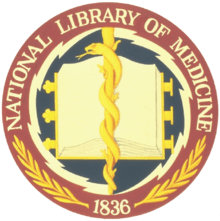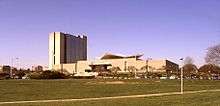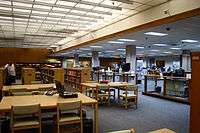United States National Library of Medicine
 Seal of the National Library of Medicine | |
|
Logo of the National Library of Medicine | |
 National Library of Medicine in 1999 | |
| Agency overview | |
|---|---|
| Formed | 1836[1] as the Library of the Office of the Surgeon General of the Army[2] |
| Headquarters |
Bethesda, Maryland, United States 38°59′45″N 77°05′56″W / 38.995951°N 77.098832°WCoordinates: 38°59′45″N 77°05′56″W / 38.995951°N 77.098832°W |
| Annual budget | $341,119,000[3] |
| Agency executive |
|
| Parent agency | National Institutes of Health |
| Website |
www |
The United States National Library of Medicine (NLM), operated by the United States federal government, is the world's largest medical library.[5]
Located in Bethesda, Maryland, the NLM is an institute within the National Institutes of Health. Its collections include more than seven million books, journals, technical reports, manuscripts, microfilms, photographs, and images on medicine and related sciences, including some of the world's oldest and rarest works.
The current director of the NLM is Patricia Flatley Brennan.[4]
Publications and informational resources
Since 1879, the National Library of Medicine has published the Index Medicus, a monthly guide to articles in nearly five thousand selected journals. The last issue of Index Medicus was printed in December 2004, but this information is offered in the freely accessible PubMed, among the more than fifteen million MEDLINE journal article references and abstracts going back to the 1960s and 1.5 million references going back to the 1950s.[6]
The National Library of Medicine also runs the National Center for Biotechnology Information, which houses biological databases (PubMed among them) that are freely accessible on the Internet through the Entrez search engine.[7]
Toxicology and environmental health
The Toxicology and Environmental Health Program was established at the National Library of Medicine in 1967 and is charged with developing computer databases compiled from the medical literature and from the files of governmental and nongovernmental organizations.[8] The program has implemented several information systems for chemical emergency response and public education, such as the Toxicology Data Network, TOXMAP, Tox Town, Wireless Information System for Emergency Responders, Toxmystery, and the Household Products Database. These resources are accessible without charge on the internet.
Radiation exposure
The United States National Library of Medicine Radiation Emergency Management System[9] provides:
- Guidance for health care providers, primarily physicians, about clinical diagnosis and treatment of radiation injury during radiological and nuclear emergencies
- Just-in-time, evidence-based, usable information with sufficient background and context to make complex issues understandable to those without formal radiation medicine expertise
- Web-based information that may be downloaded in advance, so that it would be available during an emergency if the Internet were not accessible
Radiation Emergency Management System is produced by the United States Department of Health and Human Services, Office of the Assistant Secretary for Preparedness and Response, Office of Planning and Emergency Operations, in cooperation with the National Library of Medicine, Division of Specialized Information Services, with subject matter experts from the National Cancer Institute, the Centers for Disease Control and Prevention, and many U.S. and international consultants.[9]
Extramural division
The Extramural Division provides grants to support research in medical information science and to support planning and development of computer and communications systems in medical institutions. Research, publications, and exhibitions on the history of medicine and the life sciences also are supported by the History of Medicine Division. In April 2008 the current exhibition Against the Odds: Making a Difference in Global Health was launched.
National Center for Biotechnology Information division
National Center for Biotechnology Information is an intramural division within National Library of Medicine that creates public databases in molecular biology, conducts research in computational biology, develops software tools for analyzing molecular and genomic data, and disseminates biomedical information, all for the better understanding of processes affecting human health and disease.
History
- For details of the pre-1956 history of the Library, see Library of the Surgeon General's Office.
The precursor of the National Library of Medicine, established in 1836, was the Library of the Surgeon General's Office, a part of the office of the Surgeon General of the United States Army. The Armed Forces Institute of Pathology and its Medical Museum were founded in 1862 as the Army Medical Museum. Throughout their history the Library of the Surgeon General's Office and the Army Medical Museum often shared quarters. From 1866 to 1887, they were housed in Ford's Theatre after production there was stopped, following the assassination of President Abraham Lincoln.
In 1956, the library collection was transferred from the control of the U.S. Department of Defense to the Public Health Service of the Department of Health, Education, and Welfare and renamed the National Library of Medicine, through the instrumentality of Frank Bradway Rogers, who was the director from 1956 to 1963. The library moved to its current quarters in Bethesda, Maryland, on the campus of the National Institutes of Health, in 1962.
Gallery
- The glowing facade of the National Library of Medicine at night. HMD Prints & Photos, Z AD6 U56 C25 no. M298a box 57 ins
- View of the National Library of Medicine’s main reading room, with a Mondrian-influenced modernist design. HMD Prints & Photos, PP059772.6
 Main reading room
Main reading room- The gleaming new reading room of the History of Medicine Division, in the National Library of Medicine on the National Institutes of Health campus, Bethesda, Maryland. HMD Prints & Photos, PP059772.5
 History of Medicine reading room
History of Medicine reading room- Interior view of the Binding Section. HMD Prints & Photos, PP059772.4
- View of front entrance of the new National Library of Medicine building under construction, in Bethesda, Maryland. HMD Prints & Photos, Z AD6 U56 C32 no. 27 box 58 ins
See also
Notes and references
- ↑ "A Brief History of NLM". National Library of Medicine. Retrieved September 29, 2016.
- ↑ "Our Milestones". National Library of Medicine. Retrieved September 29, 2016.
- ↑ "H.R.3020 - Departments of Labor, Health and Human Services, and Education, and Related Agencies Appropriations Act, 2016". 114th Congress. 2015.
- 1 2 "National Library of Medicine Welcomes New Director Dr. Patricia Flatley Brennan". National Library of Medicine. August 15, 2016.
- ↑ DeBakey ME (1991). "The National Library of Medicine. Evolution of a premier information center". JAMA. 266 (9): 1252–8. doi:10.1001/jama.266.9.1252. PMID 1870251.
- ↑ "PubMed". United States National Library of Medicine. Retrieved May 28, 2013.
- ↑ "NCBI Educational Resources". United States National Library of Medicine. Retrieved May 28, 2013.
- ↑ "Toxicology and Environmental Health Program". National Library of Medicine. Retrieved July 11, 2007.
- 1 2 "Radiation Emergency Management System". National Library of Medicine.
Further reading
- Miles, Wyndham D. (1992). A History of the National Library of Medicine: The Nation's Treasury of Medical Knowledge. U. S. Government Printing Office. p. 531. ISBN 9780160026447. (NLM) 8218545.
External links
| Wikimedia Commons has media related to United States National Library of Medicine. |
- Official website
- Milestones in NLM History
- Clinical Trials, research information
- AIDS Info, treatment and clinical trial information
- History of Medicine Division: Finding Aids, a multi-institutional discovery service
- Specialized Information Services, minority outreach to underserved and special populations